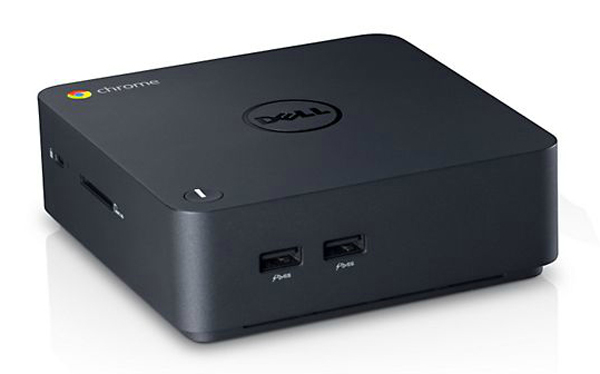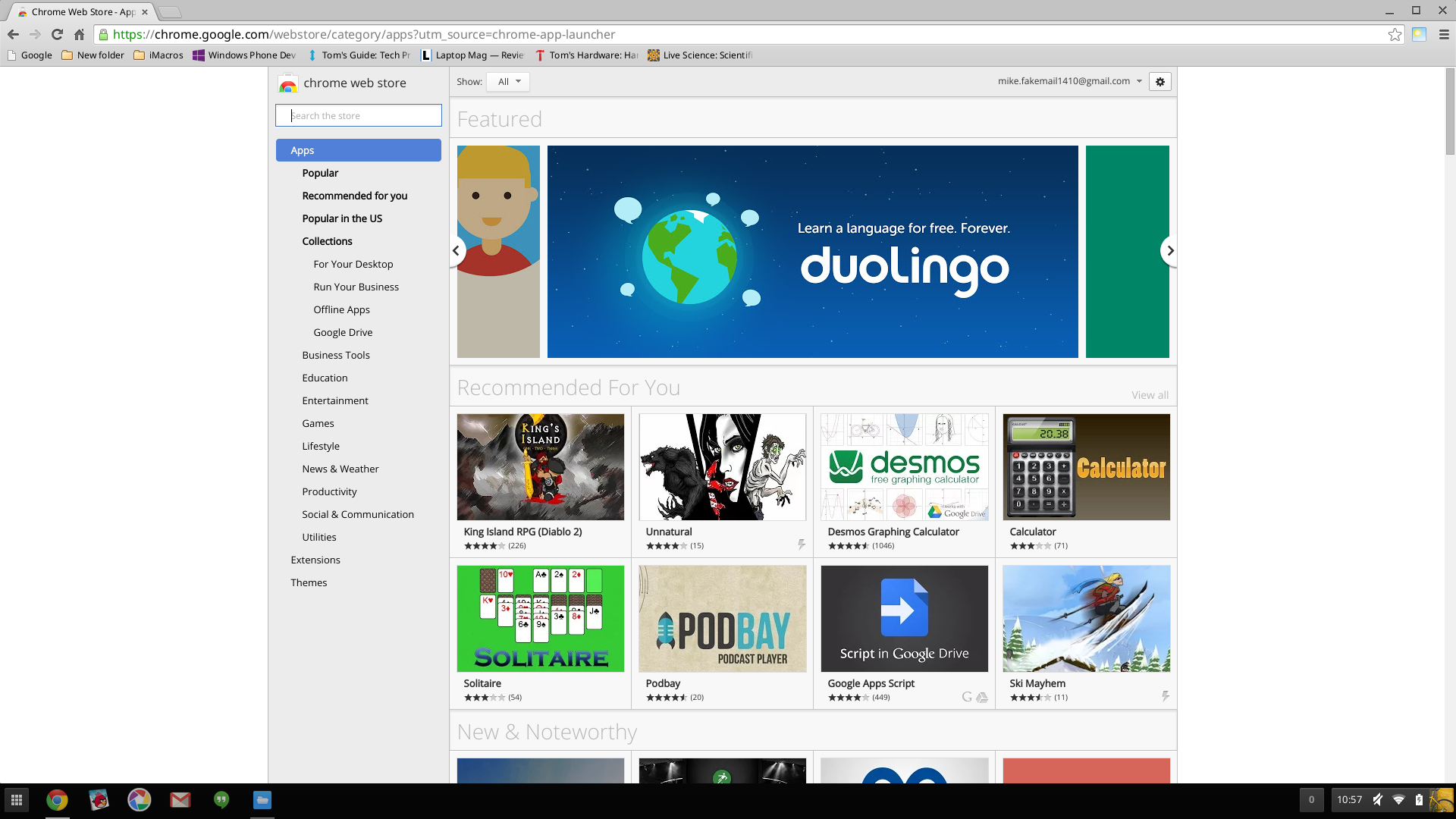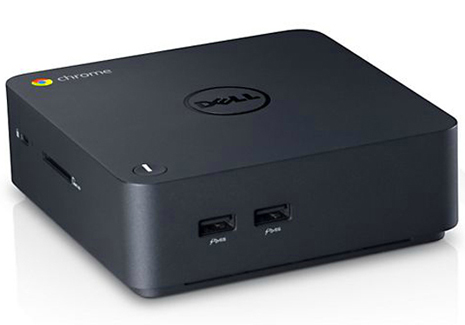Tom's Guide Verdict
The new Dell Chromebox is a speedy and powerful little device that runs Chrome OS smoothly via its Core i3 processor.
Pros
- +
Compact, versatile design
- +
Multiple ports
- +
Powerful Core i3 processor
Cons
- -
Must buy accessories separately
Why you can trust Tom's Guide
Chromebooks are everywhere, but what if you don't need to be mobile and still want something that makes it really simple to get online? That's where Chromeboxes come in. Priced at $329 (starting at $179), the Dell Chromebox brings the Chrome OS experience to your desktop in a very compact design. This device features a powerful Core i3 processor, all the ports you need and built-in Wi-Fi. Although you'll need to supply your own display and other peripherals, overall, the Dell Chromebox is a great value.
Design
The Dell Chromebox is a small black box; the Dell logo is emblazoned on the middle of the top, and a Chrome logo sits in the top-left corner, adding some color to the otherwise inconspicuous device. On the bottom-left corner is the power button, which has a light bar that turns on when the Chromebox is running.

This Chromebox is designed so that if you don't want to see it, you don't have to. You can attach it to the back of your monitor with a mounting bracket (sold separately).
MORE: Best All-in-One PCs
Measuring 4.8 x 4.8 x 1.6 inches, the Chromebox is nearly identical in size to the $135 Asus Chromebox (4.8 x 4.8 x 1.6 inches) and the $179 HP Chromebox (4.8 x 4.9 x 1.5 inches). It's pretty light as well, weighing just 1.1 pounds, which is a hair lighter than the Asus (1.3 pounds) and HP (1.4 pounds).
Ports
The front side of the Dell Chromebox houses two USB 3.0 ports, and on the back are two USB 2.0 ports, an Ethernet port, an HDMI port, a DisplayPort, an audio jack and the power port. An SD card slot and Kensington lock slot line the left side. The Chromebox also has dual-band Wi-Fi, so you can quickly connect to your home or office network.

The Chromebox also has Bluetooth 4.0 connectivity, so you can pair it with a wireless keyboard and mouse or even Bluetooth speakers.
Chrome OS
Google's Chrome OS is the Chrome Web browser — in operating-system form. This makes it ideal for Web searches and everyday tasks like checking email, shopping online and using sites like Facebook, Twitter and Pinterest.

When you boot the Dell Chromebox, you'll be asked to log in with your Gmail account. Then, you'll be taken to the desktop, which is pristine and minimal, with an icon bar on the bottom-left corner and a time stamp with your account settings button on the bottom-right corner.

The important thing to remember about Chrome OS is that every program you open will essentially open as a tab in the Chrome browser, with a few programs opening as stand-alone apps, such as Evernote, Hangouts and Duolingo.
Performance
The new Dell Chromebook is powered by a 1.7-GHz Intel Haswell Core i3-4030U processor, and that truly makes a difference when you compare it to less-powerful CPUs. With 12 Chrome tabs open, I was able to answer emails, play videos and listen to music, and the Chromebox didn't hiccup at all.
The Core i3-powered Asus Chromebox could be the Dell's twin. Both devices come with 4GB of RAM and a 16GB SSD, and both are more powerful than the $179 HP Chromebox, which sports a 1.4 GHz Intel Celeron processor. HP's device also only comes with 2GB of RAM; extra RAM is key because it facilitates multitasking and allows you to run more taxing apps like Netflix and Hulu more smoothly.
Although we haven't benchmarked other Chromeboxes yet, the Dell Chromebox is faster than its portable competition — the $305 Acer Chromebook C720, powered by a Intel Core i3-4005U processor, and the $364 Toshiba Chromebook 2, which runs a 2.58-GHz Intel Celeron N2840 processor. In the Peacekeeper test, which measures overall browser performance, its score of 3,663 bested the Acer (3,243) and the Toshiba (1,462).
The Dell Chromebox completed the SunSpider JavaScript test in a speedy 257.9 milliseconds. That's slightly faster than the Acer Chromebook C720 (268.5) and much faster than the Toshiba Chromebook 2 (564.6).
MORE: Best Gaming Desktops
Dell's Chromebox handled graphically intensive tasks well. On the Web GL Cube test, the Chromebox averaged 30 frames per second, which is much better than the Toshiba Chromebook 2's 11 fps, but not enough to beat the Acer Chromebook C720's 40 fps.
The Dell Chromebox also shined on the OortOnline.GL test, which shows a time-lapse animation of a year in the Oort Online game; its score of 4,090 put the Toshiba Chromebook 2 (1,380) to shame.
Apps
While Chrome OS is largely browser-based, you can install Web apps onto Chrome devices. Within the Chrome Web Store, apps are sorted into categories such as Education, Entertainment, Lifestyle and Productivity. There are also task-focused categories, including Online Shopping Essentials, Kitchen Companions and Run Your Business.

According to a Google representative, there are "tens of thousands of apps" in the Chrome Web Store. The number is certainly growing, but it still can't match the more than 100,000 apps in the Windows Store.
If you hook up the Dell Chromebox to a large monitor or TV, apps like YouTube, Hangouts and Netflix will run smoothly and look awesome. I used the Chromebox as both an entertainment center and as my daily PC, seamlessly switching between watching YouTube videos and editing Google Docs.
Configurations
Dell currently offers two Chromeboxes: one powered by an Intel Core i3 processor (this is the unit we reviewed), and a Chromebox featuring a 4th-generation Intel Celeron CPU. In addition to the less-powerful chip, the $179 Dell Chromebox has just 2GB of RAM.

Unfortunately, Dell doesn't offer a prepackaged bundle with the Core i3 Chromebox. However, for $199, you can get the Intel Celeron-powered Chromebox with a Dell keyboard and mouse, and for $379, you'll get the same Chromebox, keyboard and mouse, along with a Dell 23.8-inch monitor and mounting bracket.
If you're shopping for your business, you may want to consider Chromebox for Meetings. In this bundle, you get a special Chromebox with a remote, speaker, webcam, mounting bracket and one-year subscription to Dell's videoconferencing service.
Bottom Line
If you're a Chrome OS lover who doesn't need the portability of a notebook, the Dell Chromebox will serve you well. At $329, it's on the same level as a premium Chromebook, but we do wish it came with a keyboard and mouse at that price. For example, you can get the Core i3 Asus Chromebox with a wireless keyboard and mouse for $300 from Amazon — but you'll still have to provide a monitor.
But although the Dell Chromebook lacks accessories, it's big on possibilities and power. You could use the Dell Chromebox as a pseudo set-top box in your living room, streaming your favorite movies and shows from a Chrome app using a connected keyboard and mouse for more control. But even if you decide to use this Chromebox just at your desk, you'll be very happy.
Valentina Palladino is a senior writer for Tom's Guide. Follow her at @valentinalucia. Follow Tom's Guide at @tomsguide and on Facebook.
Valentina is Commerce Editor at Engadget and has covered consumer electronics for a number of publications including Tom's Guide, Wired, Laptop Mag and Ars Technica, with a particular focus on wearables, PCs and other mobile tech.
-
sl0j0n This is a great article about Dell's Chromebox, but it doesn't answer the questions that come to mind.Reply
I'm about to buy a streaming device for my old dumb TV.
I'm looking at settop boxes, streaming sticks, etc.
I'm thinking about a minipc, because I'd like to be able to check email, search online, etc. I already have a Logitech K360 wireless keyboard & mouse, but I'm not sure they'll work w/out Windoz.
So how would this Dell compare to settop boxes, streaming sticks, etc?
Would it be worth the extra dough, since we've already got 2 computers we're using, & and several more that we're not using?
That's the kind of questions I'm thinking about.
j


